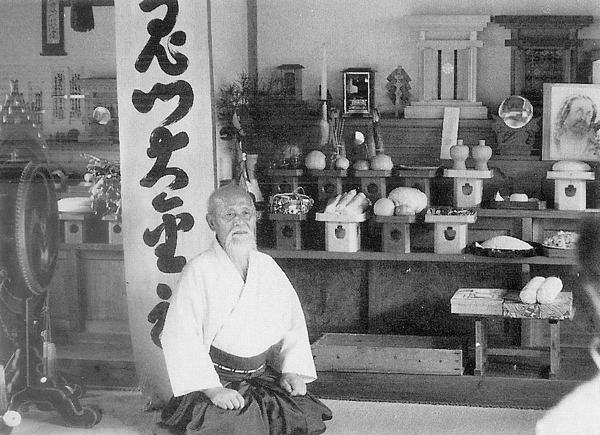
Aikido Founder Morihei Ueshiba in front of the Shinden in Iwama
Note the mitsudomoe design on the drum to his left.
Translating Morihei Ueshiba
If you haven’t read it yet, I highly recommend that you read Stan Pranin’s article “O-Sensei’s Spiritual Writings: Where did they really come from?” – it’s an important piece, and will lend some background to the rest of this post. Actually, most of this post consists of some thoughts I had after reading that article again.
To summarize from Stan Pranin’s article, there are two main sources for post-war materials from Morihei Ueshiba O-Sensei – “Takemusu Aiki” and “Aiki Shinzui”. The first is the transcription of a series of lectures by O-Sensei for publication in the Byakko Shinko Kai (“White Light Society”) newsletter. The second is also composed of transcriptions of lectures given by O-Sensei – this time the transcriptions were done by the Aikikai for publication in the “Aikido Shimbun” newsletters published by Aikikai hombu dojo.
Two major translations of these works, both by John Stevens, have been published – “The Secret Teachings of Aikido” (translated from “Aiki Shinzui”) and “The Heart of Aikido: The Philosophy of Takemusu Aiki” (translated from “Takemusu Aiki”).
The rest of what is publicly available is basically out of context fragments, mostly from oral transmissions (there are two pre-war sources of reasonable length, but we’ll leave those out for now).
So….what are the problems here?
Going backwards, let’s start out with the fragments. These are really all that we had in English, until the two translations by John Stevens above. Actually, one of his earlier publications was a collection of those various fragments, issued as “The Art of Peace“.
There is a real problem with fragments, on any subject, in Japanese, which is a highly contextual language. That’s even more the case when you’re talking about material that can be extremely abstruse and abstract – as is true with almost anything by Morihei Ueshiba.
Try giving the average Japanese person a one sentence quote from Morihei Ueshiba and in the vast majority of cases they will not be able to give you anything approaching an explanation of the meaning. In my experience, most Japanese native speakers don’t even try to make a guess – not even the Aikido practitioners.
Now, take those fragments, translate them into a very different language, and transport them out of the context of the culture that they were created in and you get…”The Art of Peace“. Something that most Japanese have difficulty understanding in the original language “understood” by non-Japanese reading an out of context translated text.
So what about the longer translations that present the material in full context – “The Secret Teachings of Aikido” and “The Heart of Aikido: The Philosophy of Takemusu Aiki“?
First of all, understand that I’m not complaining about the translations themselves.
A translation is never going to represent a completely accurate rendering of the original, since it is inevitably going to be filtered through the skills and knowledge of the translator. That always needs to kept in mind when reading any translation.
However, when you have a famous text it will normally appear in numerous translations by a wide range of translators. This allows you to compare different translations in an attempt to determine for yourself the most likely intent of the original work. Further, there will usually be a range of translations starting with editions created for popular consumption and a general readership all the way up to scholarly works with more footnotes then text.
Unfortunately, there is only one translation for each of these texts available at the current time, so….no comparisons – unless you read Japanese well.
Adding to the problem, with both”The Secret Teachings of Aikido” and “The Heart of Aikido: The Philosophy of Takemusu Aiki” we have texts that were created for popular consumption – John Stevens himself characterized “The Heart of Aikido” as “Takumusu Aiki – Lite”.
For that purpose, both of the texts were greatly simplified, edited (with many things deleted) and rearranged in order to be comprehensible to a general readership.
This isn’t a flaw – unless you accept those translations as canonical – or it’s the only translation available (as it is here). In any case it’s always important to realize why a certain translation was produced, what was done to the original text and what the background of the translator is.
Even leaving those issues aside for the moment, there’s another problem – remember the example above with the fragments and Japanese native speakers? Well, now we have the quotations in much greater context – shouldn’t they now be much easier to understand?
In my opinion, yes, but that doesn’t solve the problem, which is that most non-Japanese don’t have the cultural context to understand what they’re reading.
Don’t feel bad, even most Japanese don’t have the cultural context to understand what they’re reading, when you’re talking about this type of material!
Here’s an example from Nobuyoshi Tamura:
O-Sensei would slip into the dojo, show a few techniques, and then slip out. If he felt like it he would speak for a while. We were all young, so mostly we just wanted to get on with the practice. (on the content of the lectures) He would talk about the gods – Izanagi, Izanami and so forth. In Sakurazawa-shiki (Macrobiotics) they have some of the same ideas, so I thought that he was speaking about something concerning In and Yo, but that’s about as much as I understood.
And another from Yoshio Kuroiwa:
Q: I’ve heard that the lectures were quite long.
A: I hated it (laughing). He’d talk about the Kojikki and things, but my legs would fall asleep and I couldn’t understand anything, it just made me cry. Thinking of it now really brings things back.
Then we have the two sources in the original Japanese – “Takemusu Aiki” and “Aiki Shinzui”. If you followed my advice and read Stan Pranin’s article then you see that there is an argument to be made that that the collection of essays in “Aiki Shinzui” have been compromised.
I’m not going to walk through the arguments again, except to say that if you read both works it seems clear to me that there are significant differences between the two texts – enough so that it almost seems as if they were written by different authors.
And that brings us to “Takemusu Aiki”, with essays that were transcribed by Hideo Takahashi:
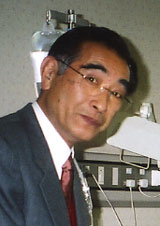
Hideo Takahashi, transcriber of “Takemusu Aiki”
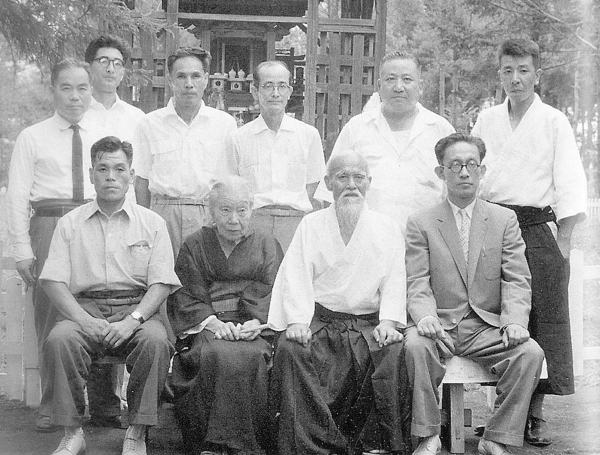
Morihei Ueshiba in front of the Aiki Shrine in Iwama
between wife Hatsu and son Kisshomaru
Back row right – Michio Hikitsuchi
Back row second from left – Hideo Takahashi
Hideo Takahashi was an editor and assistant to Masahisa Goi, who founded the Byakko Shinko Kai and created the Peace Prayer.
One reason why these transcriptions are considered to be more reliable by many people (including myself) is that Takahashi really had no horse in this race, he was drafted from outside to do one thing – transcribe Morihei Ueshiba’s lectures as accurately as possible.
Another reason is that these lectures were specifically intended for publication, and Ueshiba knew that – Takahashi consulted with him regularly, and there was ample opportunity for correction and adjustment.
Here are some interesting comments by Hideo Takahashi, translated from the Afterword to “Takemusu Aiki”:
“Takemusu Aiki” is a transcription I did of dictations from Ueshiba Morihei Sensei that were published in the Byakko Newsletter in a series of articles from the June issue of Showa year 33 (1958) to the March issue of Showa year 36 (1961).
Since Sensei didn’t like tape recorders, it was transcribed while working through the bewilderment caused by my lack of familiarity with Shinto terminology.
Each time I would go to visit the Ibaraki-ken Iwama dojo or the Tokyo Shinjuku-ku Wakamatsu-cho hombu dojo.
On hot summer days in Iwama Sensei would treat me to wine with a little water and sugar saying, “This is good to drink when it’s hot”. Once, when I relaxed a little and went out in an open-collared shirt he said, “Even when it’s hot, wearing a suit is good manners, isn’t it?”. Not wanting to cause problems, I bought my first summer suit. Even now, I still wear that suit.
I have fond memories of Sensei’s wife hunched over, serving us tea and sweets.
During the period that I was visiting Iwama about once a month, in Showa year 35 (1960) the Haiden (Front Hall) of the Aiki Jinja was completed, and in November Goi Sensei and about 100 members came to Iwama for the celebration. Sometimes Ueshiba Sensei would also come to the Byakko Hijirigaoka Dojo.
“Takemusu Aiki” contains explanations of the core principles of Aikido and the mysteries of the spirit. I believe that it is the theology of Aiki, the theology of Ueshiba.
However, the things that are spoken of here are just a small fraction of the total when compared with the notebooks that Ueshiba himself kept on hand. When I inquired after Sensei returned to the spirit world, I was told that nobody knew where they went. It is a terrible waste.
If this book can leave behind even one tiny sliver of the Kami of Aiki, the spirit of Ueshiba Morihei Sensei, then I will be blessed.
This book “Takemusu Aiki” was originally published in April of Showa year 51 (1976) by the Byakko Youth Aikido Doukoukai. For this edition I am honored to have received a recommendation and introduction from the Ni-Dai Doshu, Ueshiba Kisshomaru Sensei, the essays have been re-edited, photographs added, and a new cover added for this release to the world.
October of Showa year 61 (1986)
So where are O-Sensei’s lost notebooks?
I don’t know specifically, but I do know that there is a lot of material held by the Ueshiba family in Tokyo. Sadateru Arikawa used to spend some time with these materials while he was alive, but I don’t know if anybody at all is working with them anymore – and that would be a terrible waste.
Christopher Li – Honolulu, HI

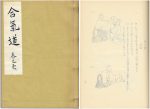
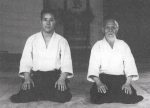

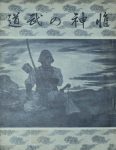


Hi Chris,
I don’t know about notebooks but when we were uchideshi in Iwama and lived day and night in the dojo, we would on occasion enter O Sensei’s room through a narrow passageway that led from the dojo to his room at the end of the building. There were (are?) many many old books stacked on bookshelves in rows. All in Japanese so sadly I could not know what they were about. I suspected it to be mainly Oomoto Kyo? I wonder if they ever been examined?
Do you know anything about them? I don’t think Saito Sensei paid much attention to them but that was probably because they belonged to the Ueshiba family and Saito would never do anything to compromise his trust with O Sensei.
Hi Bjorn,
I’ve seen them sitting there, but I don’t know. I wish that I’d taken a closer look at the time!
Best,
Chris
Thank you for a very illuminating post. What are the two pre-war sources of reasonable length you mentioned please?
Aikijujutsu Densho (Budo Renshu)and Budo. There actually a number of other articles and essays that have come to light since then from sources such as the Budo Senyokai newsletters.
Best,
Chris
There seems to be three independent English translations of contributions by O Sensei where O Sensei talks about nen.
1) Taitestu Unno in The Spririt of Aikido (1984) page 36
2) John Stevens in The Secret Teachings of Aikido (2007) page 80
3) Kei Izawa and Mary Fuller in A Life in Aikido (2008) page 188
According to A Life in Aikido, the origin of the contributions are articles contributed to the magazines Aikikai-shi and Aikido Shinbun in the 1950s.
So, there are some English translations of the same material which can be compared with each other.
However, there seems to be a lack of bibliographical references in Aikido books. The Secret Teachings of Aikido is apparently based to some degree on Aiki Shinzui. But The Secret Teachings of Aikido does not claim to be a translation of Aiki Shinzui; it doesn’t even mention Aiki Shinzui. So in principle The Secret Teachings of Aikido may contain additional material – if so, from what source?
Aiki Shinzui in turn is apparently based to some degree on articles from Aikikai-shi and Aikido Shinbun. I don’t know if Aiki Shinzui references which articles where used or if it includes previously unpublished material from other sources (or further references). It would be nice to know!
Aiki Shinzui is based entirely (as far as I know) on articles from the Aikikai Shimbun. Those articles were mostly based off transcriptions of speeches that were made by Morihei Ueshiba and recorded by Masatake Fujita. They were mainly edited by Masatake Fujita and Sadateru Arikawa.
There are some problems with the recordings. The quality was very poor – Morihei Ueshiba didn’t like being recorded, so they had to record him more or less secretly. Morihei Ueshiba also had a very difficult accent, making the transcriptions difficult. That’s combined with the difficulty of the material. I have a list of some of the obvious errors in transcription, but I’m sure that there are many more.
But the biggest difficulty is that those articles were edited (censored) by the Aikikai for content, according to Stanley Pranin, so you have to be very careful when reading them.
Best,
Chris
Thank you, Chris, for your very useful replies!